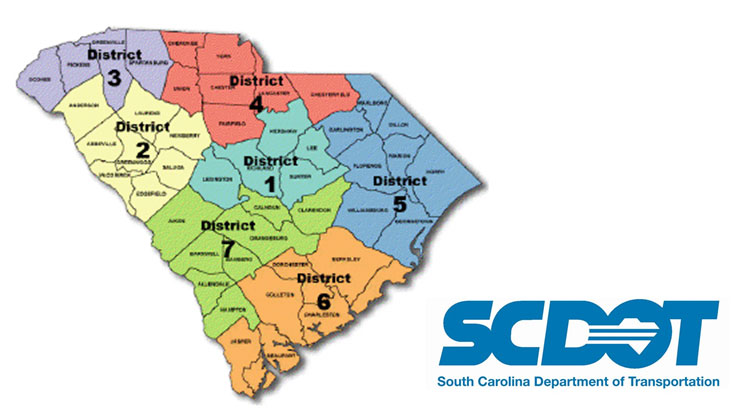
SCDOT District Map
| Name of Agency | South Carolina Department of Transportation (SCDOT) |
|---|---|
| Location | Statewide |
| Project Delivery Method | Design-Build (D-B) |
| Procurement Method | Adjusted Low Bid (Best Value) |
| Total Project Cost |
|
| Funding Source | Federal - and State-Funded (Pay as You Go Program) |
| Construction Schedule | The request for proposal (RFP) specified which bridges could be closed and which bridges needed to be staged. The D-B team was given flexibility with the schedule. |
| Project Description | South Carolina began bundling bridges with a pilot program in 2003. That project was a D-B contract, which included 33 bridges at a cost of $20 million. SCDOT took their lessons learned from the pilot project and issued a second bridge bundle contract in 2008. Again, it was a D-B contract, but this time the bridges were chosen all within District 4. With lessons learned from their first two efforts, SCDOT put out a series of contracts beginning in 2012 that they called the Letter Packages. The Letter Packages were comprised of four contracts that replaced 28 bridges at a cost of $84.5 million. These contracts were all D-B and were awarded in a two-step process. In the first step, three to five teams were shortlisted for each contract based on their qualifications. These teams were then given a chance to provide a bid. The award was based on a process that SCDOT calls adjusted low bid. Dollar values were assigned to time bid and added to the bid price. The value was then adjusted based on the technical score. In this manual, this is also referred to as best value. The Letter Packages incorporated the lessons learned from the two prior bridge bundles over the previous decade. For the sake of consistency in project delivery and for efficiency in construction, each package was put together within a single SCDOT District. In addition, to minimize risks, the following information was provided by SCDOT in the RFP:
SCDOT largely avoided locations where railroad coordination was necessary. In locations where there was railroad involvement, SCDOT performed the coordination up front and defined a box where the contractor could work. The D-B Team had to continue the coordination during construction. The costs for the railroad flaggers was paid for by the D-B Team, but it had to be passed through SCDOT. All utility relocations and coordination was the responsibility of the D-B Team. Minimal utility information was provided in the RFP. If a utility relocation was necessary and the utility company had prior rights, then SCDOT paid for the relocation. If not, then the relocation was paid for by the utility company. SCDOT did approve time extensions caused by utilities that were beyond the control of the D-B Team. If additional right-of-way was needed, the D-B Team was responsible for acquiring any right-of-way needs in the name of SCDOT. The cost for right-of-way had to be included in the project bid. Although environmental determinations were performed by SCDOT and included in the RFP, the acquisition of all environmental permits was the responsibility of the D-B Team. One of the keys to the success of the Letter Packages is the flexibility that was built into the RFP. SCDOT provides the D-B Team with information that is needed to minimize risk, but it doesn't make the RFP so restrictive that it inhibits innovation. They believe that more flexibility in the RFP leads to more efficiency on the part of the D-B Team. The SCDOT has been very successful at bundling bridges over the past 15 years. Having an established D-B program with dedicated staff makes administration of these bridge bundles easier for SCDOT than for owners who do not have the experience. The SCDOT also benefits from its willingness to incorporate lessons learned from prior bridge bundles into their program. In the time since the Letter Package bridges were completed, SCDOT has twice used bridge bundling to address emergency bridge projects after extreme flooding. Bridge bundling is a tool that SCDOT will continue to use in combination with their D-B program to maximize efficiency and achieve their desired goals. |
| Project Website | http://www.scdot.org/business/pdf/design-build/Design-Build_Procurement_Manual.pdf |
| Program Goals | To reduce the number of bridges in poor condition. SCDOT hoped to save time and money by bundling bridges together purposely. |
|---|---|
| Bridge Selection Criteria |
|
| Delivery and Procurement Method | D-B, Two-Step Process (Short List and Adjusted Low Bid) |
| Funding Sources, Financing Strategy | Federal and State Funding (Pay as You Go Program) |
| Environmental, Right-of-Way, and Utility Considerations | Utility coordination: Completed by D-B Team. |
| Risks | Most risk is on the D-B Team. The SCDOT has tried to reduce risk by providing geotechnical borings, preliminary hydrology and hydraulics and minimum span length, and field survey in the RFP. |
| Owner Management/Quality Assurance | D-B Team performs design and provides construction inspection. SCDOT reviews designs for conformance with the RFP. SCDOT provides construction inspection QC. Alternative technical concepts are permitted with the D-B process and were utilized on the Letter Packages, although none were significant. |
| Stakeholder Communication | Communication with stakeholders during design is similar to a traditional project. |